Tablettes à stylet
Esquissez, dessinez et retouchez des images avec un stylet précis sur une tablette réactive, et voyez vos créations apparaître à l'écran.

Bienvenue dans la partie suivante de cette série de tutoriels consacrée au dessin élément par élément du visage. Vous avez déjà dû recevoir de nombreux conseils et astuces pour vous aider à dessiner des personnages ou des portraits et des caricatures. Aujourd'hui, nous allons parler du nez.
Dans ce tutoriel, vous allez apprendre à dessiner un nez pas à pas.
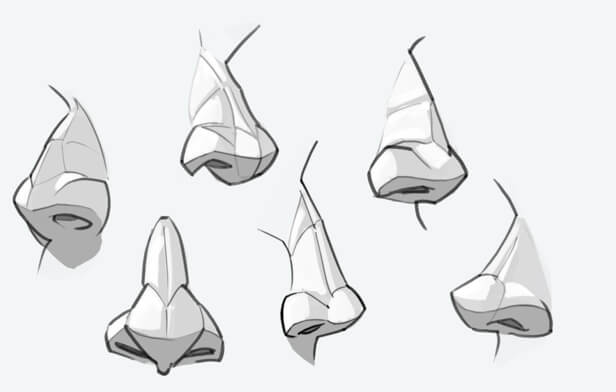

Lorsqu'on dessine le nez, le simple fait qu'il dépasse en trois dimensions du visage est probablement l'aspect le plus complexe à gérer. Pour simplifier les choses, commençons par réduire le nez à une forme géométrique, comme celle ici sur l'illustration. Il s'agit d'une pyramide dont la moitié supérieure est allongée. Cette forme nous permettra de dessiner le nez sous n'importe quel angle.
Avec un peu de pratique, vous n'aurez peut-être même pas besoin de la pyramide pour dessiner un nez dans la plupart des cas. Mais vous aurez parfois envie de dessiner un visage sous un angle plutôt inhabituel. Dans ces cas-là, vous aurez peut-être du mal à déterminer à quoi ressemblera le nez. La pyramide vous y aidera.
Pour que la pyramide soit de la bonne forme, nous commençons par tracer une croix à la base, puis nous traçons la hauteur à partir de son centre (en pointillés sur l'image). On obtient ainsi tous les coins, y compris le sommet. Il suffit maintenant de les relier tous.

Comme vous pouvez le voir, la pyramide prend des formes très différentes selon les angles. Si vous êtes suffisamment sûr(e) de vous, vous pouvez aussi essayer de dessiner la pyramide à main levée. Mais il est généralement plus sûr de commencer par la croix à la base.
À partir de là, basez-vous sur la tête.

Pour apprendre à dessiner un nez, mieux vaut commencer par dessiner le visage de face. Ici, je vais utiliser les formes de tête des tutoriels précédents, bien sûr.

(1) Tout d'abord, nous aurons besoin du triangle entre les yeux que nous avons appris à dessiner dans le tutoriel « Comment dessiner des yeux ». Ce triangle délimite la zone entre les sourcils et l'os du nez.

(2) Ensuite, nous allons dessiner la croix de notre pyramide. À ce stade, nous pouvons déjà déterminer la largeur de notre nez. En moyenne, la largeur du nez correspond à peu près à la distance entre les yeux. Je vais donc conserver cette largeur pour ce nez.
La croix permet également de déterminer si le nez pointera vers le haut ou vers le bas. Plus la croix est haute, plus le nez pointera vers le haut.
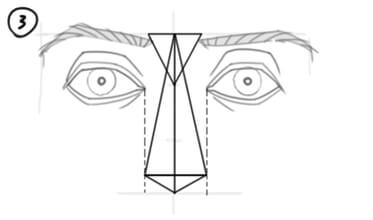
(3) Vu de face, nous n'avons pas besoin de dessiner la hauteur de la pyramide puisqu'elle épouse naturellement la forme de la croix dans cette perspective. N'oubliez pas que cette règle ne vaut que pour la vue de face.

(4) Transformons maintenant la pyramide en nez. La pointe du nez se trouve au sommet de la pyramide. Pour la représenter, il suffit de tracer un cercle. Si vous dessinez un cercle plus petit, le nez aura l'air plus pointu. Il peut parfois être judicieux de tracer un hexagone ou un losange à la place du cercle pour dessiner la pointe du nez. Mais restons-en au cercle ici.

(5) Avec les deux coins inférieurs de notre pyramide, nous allons dessiner les ailes du nez. Vous pouvez utiliser les lignes pour vous guider, comme sur l'illustration. Sous la pointe du nez, nous marquons le septum (c'est-à-dire la partie entre les narines) en traçant deux autres lignes. Il doit s'effiler vers le bas.

(6) Nous pouvons maintenant dessiner les narines à partir du bord inférieur. Il suffit de dessiner deux U étroits inversés, légèrement tournés vers l'extérieur. Le haut des narines se trouve au niveau de la croix de la pyramide.

(7) La ligne entre le haut et le bas du nez est une ligne cruciale. Son importance ne saute peut-être pas aux yeux au premier abord, mais elle vous sera très utile plus tard pour déterminer les parties claires et les parties sombres du nez au moment de la mise en couleur. Il s'agit aussi d'un support formidable pour ajouter une perspective en trois dimensions à votre dessin.
Dessinez une vague en suivant le bord inférieur du cercle à la pointe du nez. Je l'appelle la « vague de la pointe du nez ». C'est plus drôle en allemand, vraiment.

(8) Maintenant, dessinons l'arête du nez. Elle n'est pas toujours prononcée sur tous les nez : il suffit parfois d'y faire subtilement allusion. Surtout, il faut savoir que, comme sur l'illustration, elles se compose de deux zones qui s'élargissent légèrement vers le milieu. L'os propre du nez se situe dans la partie supérieure. L'os se trouve directement sous la peau. En dessous, il n'y a plus d'os.
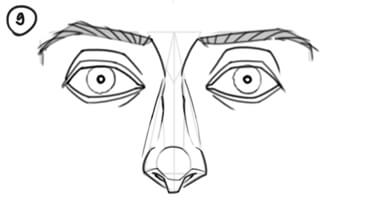
(9) Enfin et surtout, on peut très facilement dessiner le nez à partir de notre construction. À vous de décider les lignes que vous souhaitez accentuer, et celles que vous voulez dissimuler. J'ai enlevé les côtés de la pointe du nez pour adoucir la transition entre la pointe et l'aile. Sur l'arête, j'ai légèrement insisté sur l'os propre du nez tout en soulignant les bords des deux triangles.

Il est très utile de retirer et de réduire des éléments, notamment au niveau des contours du nez. Si le visage que vous dessinez ne fait que quelques centimètres, vous n'allez probablement pas vous focaliser sur l'os du nez. Donc, en fonction de l'image, choisissez le degré de détails qu'il vous faut. Parfois, quelques lignes suffisent pour indiquer qu'il y a un nez là. Mais dès que vous ne savez pas exactement comment et où dessiner les lignes, essayez de le construire correctement pour éviter de vous retrouver avec un nez complètement déformé.

(1) De profil, le nez paraît complètement différent d'un nez vu de face. Pourtant, nous utilisons la même méthode pour le construire. Commencez là aussi avec le triangle entre les sourcils. Mais cette fois, le triangle se transforme en ligne puisque nous le voyons de côté.
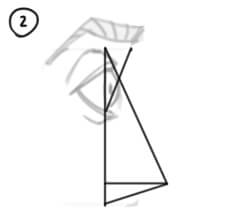
(2) On positionne la pyramide derrière la ligne du « triangle ». De cette façon, le retrait se situe approximativement au niveau de la paupière supérieure.

(3) Pour la pointe du nez, nous utilisons cette fois un losange. Mieux vaut éviter les traits bien droits lorsque vous dessinez le losange. Tracez plutôt de traits légèrement courbés vers l'extérieur. Votre nez paraîtra beaucoup plus naturel.

(4) Placez l'aile du nez au bord de la pyramide, comme auparavant. Bien sûr, vu de profil, nous n'en voyons qu'une. Sous la pointe du nez, la ligne tracée pour relier le nez est pratiquement horizontale. Et juste en dessous, c'est le début du philtrum.

(5) La narine est assez étroite de ce point de vue, voire totalement invisible. Pour suggérer la narine, nous devons dessiner le bord inférieur de l'aile du nez. Comme vous pouvez le voir sur les trois variantes, vous pouvez commencer la ligne à la pointe du nez, mais aussi dans le coin de la pyramide. Moi, j'ai choisi de la dessiner séparément ; ça marche aussi.
(6) Le nez crée des profils très différents, et il peut être très caractéristique. Vous aurez besoin d'exactement sept traits le long de l'arête de la pyramide.

(7) Et là encore, nous pouvons ajouter ou supprimer certaines lignes de construction au fur et à mesure. La « vague de la pointe du nez » (partant de la droite sur l'illustration) et la ligne faisant allusion à la pommette (partant de la gauche) sont deux lignes très utiles.
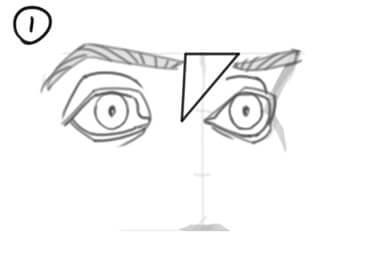
(1) Pour la vue de demi-profil, il faut faire preuve d'un peu plus d'imagination spatiale que pour la vue de profil complet ou la vue de face. Comme vous pouvez le voir, le triangle entre les sourcils est un peu décalé vers la gauche.

(2) Soyons très consciencieux cette fois et commençons par reprendre là aussi la distance entre les yeux pour la pyramide.

(3) On obtient ainsi l'espace nécessaire pour dessiner la croix pour la base.
(4) On peut déterminer la hauteur de la pyramide à partir du centre, autrement dit la saillie du nez par rapport au visage.
(5) Il ne nous reste plus qu'à relier les coins et notre pyramide est prête.

(6) Pour la pointe du nez, on peut choisir une forme plus complexe. Imaginons l'hexagone comme un objet incurvé en trois dimensions : un hémisphère ou un bol, par exemple. Compte tenu du pivotement de la perspective, les angles de l'hexagone sur le côté gauche seront un peu plus plats. Inutile d'être ultra précis, mais le nez paraîtra ainsi un peu plus naturel.

(7) Les traits pour l'aile du nez commencent sur le bord de la pyramide, comme d'habitude. J'ai choisi de dessiner une narine très franche ici.
(8) On peut aussi choisir de souligner l'arête et le dessous du nez.

(9) La pointe de notre nez est en fait constituée de deux parties distinctes. Parfois, la séparation de ces deux parties prend la forme d'un pli au milieu de la pointe du nez. Essayons avec ce nez, et traçons un pli au centre.
(10) La transition entre le pli de la pointe et l'arête du nez forme désormais un V. Concrètement, il faut remplacer la partie supérieure de notre hexagone formant la pointe du nez par une forme en V.
(11) Cette fois-ci, on laisse la « vague de la pointe du nez » passer directement par le milieu de la pointe du nez au lieu de la faire passer sous celle-ci. On peut aussi adapter légèrement la vague pour s'adapter à l'angle voulu.
(12) Ajoutez quelques traits fins supplémentaires pour souligner les bords de l'arête et de la pyramide. Sur notre nez, le pli au centre remonte jusqu'à l'os propre du nez.

(13) Ne soyez pas trop pressé(e) d'effacer toutes les lignes de construction. Certaines rendent plutôt bien sur le dessin final. Comme vous pouvez le voir, je n'en ai effacé que quelques-unes, celles que je ne voulais pas autant mettre en avant. L'hexagone déformé et incurvé à la pointe du nez est suffisamment naturel pour être conservé tel quel sur le dessin final.
Vu de dessous, le nez a l'air très différent. Voici comment dessiner un nez du dessous.

(1) Comme avant, nous nous baserons sur la forme d'une pyramide. Désormais vue de dessous, elle prend la forme d'un triangle traversé par un axe central.

(2) Au sommet du triangle, la pointe du nez correspond de nouveau à un cercle ou à un hexagone.
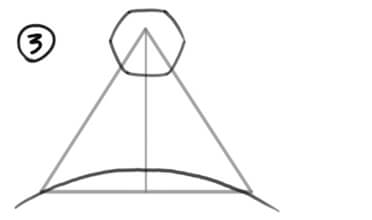
(3) Dans cette perspective, la zone au-dessus de la bouche apparaît juste en dessous du nez. Mais au lieu d'être plate, la crête des dents est plutôt arrondie sous cet angle. Il nous suffit d'adapter le bord inférieur plat de la pyramide pour y intégrer cet arrondi.

(4) Les ailes du nez correspondent aux lignes reliant les coins de la pyramide à la pointe du nez. Pour donner de l'épaisseur et de la consistance aux ailes, vous pouvez les dessiner à l'aide de deux jolis traits comme illustré sur l'image.

(5) Entre la pointe du nez et la crête des dents, on aperçoit le bord inférieur du septum.

(6) Un peu plus vers la pointe du nez, le septum s'épaissit. Pour le représenter, on dessine une bosse de chaque côté du septum.

(7) Les narines ressemblent à des O allongés à la forme de bulbes.
(8) Sur l'extérieur, la ligne de l'aile du nez est parallèle à la narine. En haut, la ligne touche la pointe du nez, tandis qu'en bas, elle recouvre l'arrondi.

(9) Et bien sûr, l'intérieur de la narine est sombre. Attendons pour le moment avant de passer aux ombres. Restons-en aux lignes pour le moment. Vous pouvez bien sûr toujours peindre les narines en foncé, mais ne le faites pas avant d'avoir tracé tous les contours et toutes les lignes de construction.

(1) Pour finir, essayons de dessiner le nez vu de dessous avec un angle. Notre triangle en haut sera plus allongé sous cet angle, et encore une fois décalé sur le côté.

(2) Il ne sera pas forcément facile de décider où nous allons placer la base de la pyramide sous cet angle. Mais d'après la vue du profil, nous savons que la base traverse le triangle du haut à mi-hauteur. Et nous savons que le bord inférieur de la pyramide croise la ligne de guidage pour la forme de notre tête. Ces deux points vont nous permettre d'identifier l'axe central.
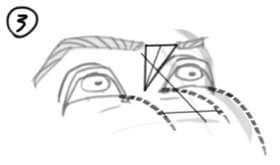
(3) Sous cet angle, il est un peu compliqué de calculer la largeur du nez à partir de la distance entre les yeux, comme nous l'avons fait auparavant. En fait, ces lignes en pointillées ne sont plus droites. Désormais, elles suivent la courbe des joues (d'ailleurs, c'est également le cas dans la vue de demi-profil).

(4) L'axe au sommet de la pyramide doit être orienté dans la même direction que la tête.

(5) On en a terminé avec la partie la plus difficile ; la pyramide est maintenant en place.
(6) Adaptez la courbe représentant la zone entre la bouche et le nez en fonction de la direction d'observation ; elle doit s'aplatir et s'élargir du côté qui fait face à la personne qui regarde. Plus précisément, nous dessinons ici la partie supérieure d'une ellipse déformée.

(7) Là aussi, l'hexagone est une bonne option pour dessiner la pointe du nez. Il va nous être utile pour détailler les courbes en trois dimensions.
(8) Passons maintenant à la technique de dessin.
(9) Les renflements à gauche et à droite du septum ne sont pas visibles de la même façon sous cet angle. Celui à droite est presque entièrement caché par le septum.

(10) Nous voyons également moins la narine à droite par rapport à celle à gauche.
(11) Et l'arête du nez semble aussi très étroite. Plus on regarde vers le bas, plus le nez lui-même se raccourcit.
(12) La "vague de la pointe du nez" se situe dorénavant précisément le long de la ligne rouge.

(13) Enfin, nous pouvons ajouter de l'ombre aux narines. Et quelques hachures légères nous permettent d'atténuer un peu les bords, comme ici entre la pointe du nez et le septum.

J'espère que j'ai pu vous aider à vaincre un peu cette peur du « nez tant redouté ». Peut-être même deviendra-t-il la partie du corps que vous préférez dessiner. On peut vraiment s'amuser à dessiner les nez, notamment lorsqu'on dessine des personnages de dessins animés ou des caricatures. Profitez-en pour montrer toute l'étendue de votre talent. À vous de jouer !
À bientôt !
Wacom One offre les sensations familières du crayon sur le papier grâce à un écran de 13,3 pouces avec une surface à la friction naturelle et un minimum de reflet. Léger et naturel dans votre main, le stylet se transforme en crayon, pinceau ou craie dans le logiciel que vous avez choisi. Tout ce qu'il vous faut pour dessiner un nez réaliste. Un logiciel de création est inclus, de même que la possibilité de vous connecter à votre ordinateur et à certains appareils Android.

Écran interactif Wacom One 13
Dessinez, concevez et créez directement sur un écran haute résolution avec un stylet précis.

Esquissez, dessinez et retouchez des images avec un stylet précis sur une tablette réactive, et voyez vos créations apparaître à l'écran.

Dessinez, concevez et créez directement sur un écran haute résolution avec un stylet précis.

Écrivez au stylo sur le papier et convertissez vos notes manuscrites au format numérique.
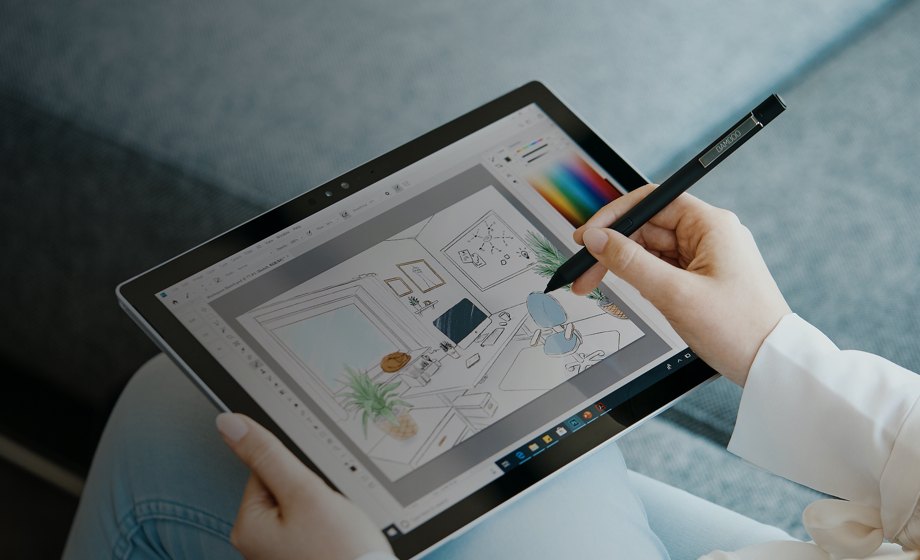
Écrivez et notez rapidement vos idées sur votre appareil mobile avec un stylet Wacom.
Forte de sa vision, rapprocher l'humain de la technologie grâce à des interfaces naturelles, la société Wacom est devenue le numéro un mondial de la fabrication de tablettes à stylet et d’écrans interactifs, de stylets numériques et de solutions pour l’enregistrement et le traitement des signatures électroniques. La technologie avancée intégrée aux dispositifs de saisie Wacom est à l’origine des plus belles œuvres dans le domaine des arts numériques, des films, des effets spéciaux, de la mode et du design à travers le monde : les professionnels et les particuliers bénéficient grâce à elle d'une interface high-tech pour exprimer toute leur personnalité. Créée en 1983, Wacom est une société internationale dont le siège est situé au Japon (bourse de Tokyo : 6727). Elle possède des succursales et des filiales dans le monde entier, avec un réseau de marketing et de distribution implanté dans plus de 150 pays.